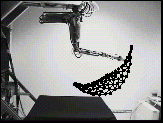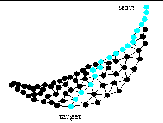Vision-Based Path Planning
A very important step towards autonomous robotics is developing ways to generate motion plans for achieving certain goals while satisfying environmental constraints. Classical motion planning is defined on a configuration space which is assumed to be known, implying the complete knowledge of both the robot kinematics as well as knowledge of the obstacles in the configuration space. On the other hand, vision-based, or more general, sensor-based path planning provides a more practical approach to robot control. To best utilize the sensor feedback, a robot motion plan should incorporate constraints from the sensor system as well as criteria for optimizing the quality of the sensor feedback.

 (top) SoftArm robot system and network structure in the workspace
as seen by the camera. The learning has been accomplished and the network
represents the topology of the PCM. (bottom) Visual components of the
mapping and a motion plan (color units) generated in configuration (encoder)
space after start and target have been defined in vision space.
(top) SoftArm robot system and network structure in the workspace
as seen by the camera. The learning has been accomplished and the network
represents the topology of the PCM. (bottom) Visual components of the
mapping and a motion plan (color units) generated in configuration (encoder)
space after start and target have been defined in vision space.
We therefore combined a novel approach to robot motion planning, based on the concept of the Perceptual Control Manifold (PCM) with a Topology Representing Network (TRN) architecture. On one side, the PCM provides a flexible way of developing motion plans that exploit sensors effectively, on the other side, using a neural network to learn the topology of the PCM manifold leads to a path plan, even with robotic systems, such as the SoftArm, where the PCM cannot be derived analytically. The Figure depicts the network structure as seen by one camera after a training session of 1000 random moves. The TRN has learnt the PCM topology and on the left side of the Figure a path plan has been generated in configuration space by defining start point and target in vision space. Since the network models configuration and sensor space at the same time, obstacles can be projected onto the topology and included in the path plan, e.g. by disableing certain connections within the network. To further enhance the capabilities of our system, a diffusion-based path planning algorithm was implemented.
This work is undertaken by Michael Zeller in collaboration with Rajeev Sharma, Department of Computer Science and Engineering, Pennsylvania State University.
Related Publications
A detailed account of this work can be found in the following publications:



